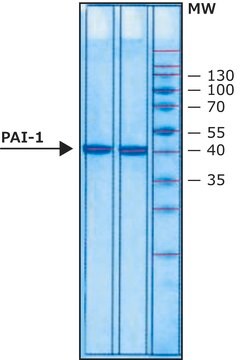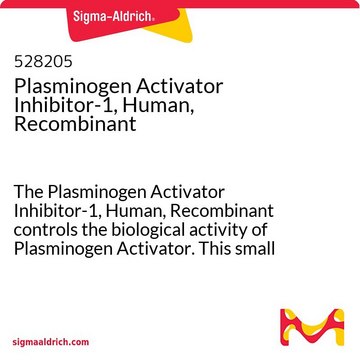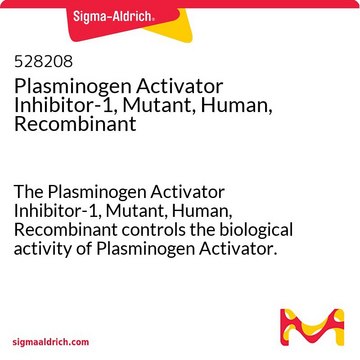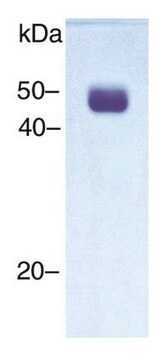CC4075
Human Plasminogen activator inhibitor-1
liquid, ≥98% (SDS-PAGE), suitable for activity assay
Synonym(s):
PAI 1, SERPINE1, PAI1
Sign Into View Organizational & Contract Pricing
All Photos(2)
About This Item
UNSPSC Code:
12352202
eCl@ss:
32160405
NACRES:
NA.77
Recommended Products
product name
Human Plasminogen activator inhibitor-1, recombinant,
biological source
human
Quality Level
assay
≥98% (SDS-PAGE)
form
liquid
manufacturer/tradename
Chemicon®
technique(s)
activity assay: suitable
impurities
<1 EU/μg endotoxin
NCBI accession no.
UniProt accession no.
shipped in
dry ice
General description
Plasminogen activator inhibitor-1 (PAI-1) is a member of the serine protease inhibitor (serpin) superfamily and a central regulatory protein in the blood coagulation system. PAI-1 is unique among serpins in exhibiting distinct active and inactive (latent) conformations in vivo. Human PAI-1 is a single-chain glycoprotein with a molecular weight of 43 kDa. This inhibitor acts as "bait" for tissue-type and urokinase-type plasminogen activators (tPA and uPA) and protein C. Its rapid interaction with tPA may function as a major control point in the regulation of fibrinolysis. The highly mobile reactive-center loop (RCL) is thought to account for both the rapid inhibiton of plasminogen activators, and the rapid and spontaneous transition of the unstable, active form of PAI-1 into the stable, inactive conformation (t1/2 at 37oC, 2 hours). The inactive form can be partially reactivated by denaturants such as urea, guanidine hydrochloride or SDS. High concentrations of PAI-1 have been associated with human thromboembolic disease. PAI-1 activity may limit the extent of tumor metastasis, since uPA activity is a major contributory factor promoting dissolution of tumor matrix and basement membrane.
The sequence corresponding to amino acids 24 to 402 of human PAI-1 (mature form) tagged with 6xHis on the carboxy-terminal was expressed in E. Coli.
Application
To fully activate the latent PAI-1, the PAI-1 must be incubated in Activation Buffer (2X Activation Buffer: 8 M Guanidine HCl, 40 mM Sodium Acetate, pH 5.6, 400 mM NaCl, 0.2% Tween 20) for 15 to 30 minutes (Sancho, 1994).The recombinant PAI-1 is able to bind to uPA resulting in a SDS-stable complex.
Physical form
Liquid. In 150 mM Na2HPO4, pH 6.6, 500 mM NaCl, 2 mM Glutathione, and 0.01% Tween-80.
Storage and Stability
Store at -80ºC. Thaw on ice and freeze aliquots at -80ºC for longer storage. This product is stable for at least 2 years as supplied. Avoid repeated freeze/thaw cycles.
Analysis Note
Specific Activity: By uPA activity assay, the recombinant PAI-1 contains a mixture of the active and latent forms, with >45% of active form
Legal Information
CHEMICON is a registered trademark of Merck KGaA, Darmstadt, Germany
Disclaimer
Unless otherwise stated in our catalog or other company documentation accompanying the product(s), our products are intended for research use only and are not to be used for any other purpose, which includes but is not limited to, unauthorized commercial uses, in vitro diagnostic uses, ex vivo or in vivo therapeutic uses or any type of consumption or application to humans or animals.
Storage Class
10 - Combustible liquids
wgk_germany
WGK 2
flash_point_f
Not applicable
flash_point_c
Not applicable
Certificates of Analysis (COA)
Search for Certificates of Analysis (COA) by entering the products Lot/Batch Number. Lot and Batch Numbers can be found on a product’s label following the words ‘Lot’ or ‘Batch’.
Already Own This Product?
Find documentation for the products that you have recently purchased in the Document Library.
P M Sherman et al.
The Journal of biological chemistry, 267(11), 7588-7595 (1992-04-15)
Plasminogen activator inhibitor-1 (PAI-1) is a specific inhibitor of the serine proteases tissue-type plasminogen activator (tPA) and urokinase-type plasminogen activator (uPA). To systematically investigate the roles of the reactive center P1 and P1' residues in PAI-1 function, saturation mutagenesis was
Our team of scientists has experience in all areas of research including Life Science, Material Science, Chemical Synthesis, Chromatography, Analytical and many others.
Contact Technical Service








